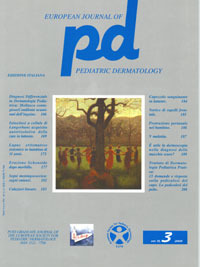Perianal protrusion in childhood.
Downloads
How to Cite
Ingordo V., Iannazzone S.S., Cusano F. 2005. Perianal protrusion in childhood. Eur. J. Pediat. Dermatol. 15 (3): 186.
pp. 186
Abstract
The term infantile perineal pyramidal protrusion -IPPP-(1) defines a benign condition clinically characterized by a solitary pyramidal protrusion, pink or skin colored, localized on the median perineal region in front of the anus, mainly affecting females. The first reports of perianal protrusions in prepubertal girls date back to 1989. Since then about 90 cases of IPPP have been reported (1-6). Three types of IPPP were identified as follows: constitutional IPPP, which sometimes can be inherited e/o familial, functional IPPP and IPPP associated to lichen sclerosus and atrophicus -LSA-(6). Its pathogenesis is unknown. However, a particular constitutional laxity of the female perineum was hypothesized. The latter could explain the increased prevalence of IPPP in females (4). Congenital IPPP is considered by some Authors as a residuum of the tip of urogenital septum, because perineum is made of a lengthening of the urogenital septum during growing of the fetus (5). In most cases the papule was reported on the median line, in front of the anus, but in some cases it was reported behind the anus and rarely it was double, localized on both sites (6). In the congenital cases the protrusion was not pyramidal in shape, but rather flattened like a leaf (5, 6). This is why Patrizi et Al. talk about perianal (and not perineal) infantile protrusion (IPP), omitting the term pyramidal (6). According to some Authors (1, 4), in the acquired or functional forms of IPPP constipation, diarrhea, fistulas, anal fissurations and diaper rash play a pathogenetic role. Functional or acquired IPPP should be differentiated from condylomata acuminata, sexual abuse and sentinel hemorrhoid. Finally, some forms of IPPP are associated to LSA. In these cases the diagnosis is exclusively histological in some cases (3, 6). On the other hand, in other cases the clinical features are very characteristic due to the presence of whitish atrophy or typical lesions in other sites (6).Keywords
Perianal protrusion

